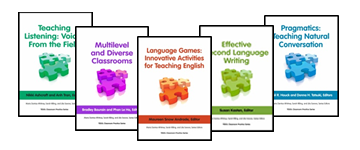Ideas for Teaching Spoken Grammar
by Amanda Hilliard
 Traditionally, formal descriptions of English grammar have been based on standards of written English. However, recently, particularly as a result of analysis of large corpora of spoken data and an emphasis on spoken communication, researchers and linguists are beginning to focus on describing features of spoken grammar, and there has been increasing interest in understanding and teaching spoken grammar. After all, spoken grammar has arisen to meet the needs of natural spoken conversation, and teaching it in the language classroom can help teachers avoid “producing speakers of English who can only speak like a book” (Carter & McCarthy, 1995, p. 207). Although there is still some debate as to what constitutes spoken grammar and the extent to which it should be taught, raising students’ awareness of spoken grammar can help improve their communication abilities and comprehension skills, particularly in cases where students are learning English in order to communicate with native speakers. This article presents some activities and ideas teachers can use to raise students’ awareness of and ability to produce features of spoken grammar such as fillers, backchannels, heads, tails, and ellipses.
Traditionally, formal descriptions of English grammar have been based on standards of written English. However, recently, particularly as a result of analysis of large corpora of spoken data and an emphasis on spoken communication, researchers and linguists are beginning to focus on describing features of spoken grammar, and there has been increasing interest in understanding and teaching spoken grammar. After all, spoken grammar has arisen to meet the needs of natural spoken conversation, and teaching it in the language classroom can help teachers avoid “producing speakers of English who can only speak like a book” (Carter & McCarthy, 1995, p. 207). Although there is still some debate as to what constitutes spoken grammar and the extent to which it should be taught, raising students’ awareness of spoken grammar can help improve their communication abilities and comprehension skills, particularly in cases where students are learning English in order to communicate with native speakers. This article presents some activities and ideas teachers can use to raise students’ awareness of and ability to produce features of spoken grammar such as fillers, backchannels, heads, tails, and ellipses.
Fillers and Backchannels
Fillers and backchannels are utterances like “er” and “erm” that do not have a specific meaning but rather fill time and allow speakers to gather their thoughts (Willis, 2003). Fillers are used by both the listener and speaker. At the beginning of a turn, they signal that the listener has heard the response and needs a little time to respond; after completion points, when it seems that the speaker may have finished his or her turn, they signal that the turn is not really over and that the speaker intends to continue (Willis, 2003). Backchannels, on the other hand, are utterances such as “uh-huh” and “really,” which are used by the listener to acknowledge what the speaker is saying and encourage him to continue. Both fillers and backchannels are common in English conversation because they serve important conversational and interpersonal functions, and it would be both difficult and awkward to have a conversation without them (Willis, 2003). Moreover, international students who underuse fillers and backchannels may have difficulty maintaining natural communication with native speakers.
To raise students’ awareness of fillers and backchannels, the teacher can explain their function and then ask students to categorize a group of words as either fillers or backchannels, as in the example below. Once the class has discussed the answers, the teacher can play a short video clip and ask students to count the number of fillers and backchannels they hear in the clip. This activity shows students how common these words are in conversational English.
|
Directions: Put the following words in the correct column below.
Oh, hmmm, ah, um, I see, uh huh, er, really
|
Fillers: words that give you time to think, create a pause, or indicate you’re not finished talking |
Backchannels: words that show you are listening and understand what someone else is saying |
|
|
|
|
|
|
|
|
|
|
|
| |
Heads and Tails
Heads are a way to introduce and orient listeners to a topic before giving information on the topic. For example, in the question, Your sister, does she speak English too?, “your sister” is the question head that introduces the listener to the topic. Heads allow speakers to highlight the topic they want to talk about before commenting on it, giving both the speaker and the listener more processing time in real-time communication (Cullen & Kuo, 2007). On the other hand, tails are comments that are added to the end of a phrase. Tails allow speakers to emphasize or evaluate their comments, and can also be used to clarify the subject of the sentence (Timmis, 2009). For example, in the sentence, She’s a very pretty girl, Amanda is, “Amanda is” acts as a tail that clarifies the subject “she.”
Some basic activities to teach students about heads and tails include questions and statements written with and without heads and tails, as in the examples below. The teacher asks students to decide which is more or less formal, or which is more likely to be found in written or spoken English. After discussing and explaining the use of heads and tails in spoken English, the teacher then asks students to underline the heads or tails in each of the example questions and sentences. In another possible activity the teacher gives students some sentences or questions that already contain heads and tails and asks them to rewrite them without the heads or tails. Then, the teacher gives students sentences that do not contain heads or tails and asks them to rewrite them with heads or tails. These activities raise students’ awareness of the function and use of heads and tails in spoken English.
|
Directions: Which sentence or question below is more formal? Can you underline the head or tail in the sentences and questions below? Why does the speaker use them? Can you rewrite the sentences and questions without the head or tail?
1. a. Isn’t your brother a soccer player?
b. Your brother, he’s a soccer player, isn’t he?
2. a. Robert is really clever.
b. He’s really clever, Robert is. |
Because heads and tails create two-part sentences and questions, the class can also be divided into pairs and create their own heads and tails together. If the first student starts with a head, the second student finishes with the rest of the question or sentence; if the first student starts with a statement or question, the second student finishes with an appropriate tail. This can be turned into a game in which students receive points for correctly completing their partner’s sentence or question.
Ellipses
Situational ellipses, used when omitting items that are apparent from the immediate situation, are common in spoken English and often result in the omission of subjects and verbs. Because speakers have a shared context, they are able to reduce the length and complexity of their comments by leaving out unnecessary information (Cullen & Kuo, 2007). To teach students about ellipses, teachers can select a short video from a TV show where two friends are talking. The teacher gives students a script that includes all the omitted subjects and verbs and asks students to cross out words that they do not hear in the video clip. Once students have listened and crossed out the words, the class can discuss which words were omitted and why. Students can also discuss which words can and can’t be omitted.
In another activity, teachers can start with a short conversation that includes ellipses and ask students to write a long version of the conversation by filling in the missing words, leading to a discussion about which words can be omitted and why. Alternatively, teachers can ask students to write out two identical conversations with a partner: a long version and a short version. This activity helps students incorporate ellipses into their spoken production.
Finally, ellipses can be incorporated into short games. After dividing students into groups, the teacher writes a long question or sentence on the board. The teacher then goes around the room, giving each team a point for every new, shorter question or sentence they create. When no group can come up with a new, shorter question or sentence, the teacher writes a new question or sentence on the board, and the game starts over. Similarly, in groups of four, students can challenge each other. Pair A creates a long question and answer, and Pair B makes a short version of it. If Pair B creates an acceptable short question and answer, the pair gets a point; if Pair B does not, Pair A gets the point. The students can decide for themselves if the shorter version is acceptable or not, and if they are not sure, the teacher acts as a judge. After a few rounds back and forth, the game changes so that Pair A creates a shorter version of a sentence or question and Pair B must give a longer version. Again, the teacher monitors the groups and settles any disputes.
Conclusion
This article has presented some specific activities teachers can use to teach elements of spoken grammar in the ESL classroom, particularly fillers, backchannels, heads, tails, and ellipses. With the emphasis on communication and speaking, it is more vital than ever to teach features of spoken grammar in order to help students become more effective and natural speakers of English.
References
Carter, R., & McCarthy, M. (1995). Spoken grammar: What is it and how can we teach it? ELT Journal, 49(3), 207–218.
Cullen, R., & Kuo, I. (2007). Spoken grammar and ELT course materials: A missing link? TESOL Quarterly, 41(2), 361–386.
Timmis, I. (2009). “Tails” of linguistic survival. Applied Linguistics, 31(3), 325–345.
Willis, D. (2003). Rules, patterns, and words: Grammar and lexis in English language teaching. Cambridge, England: Cambridge University Press.
________________________
This article originally appeared in the July 2012 issue of HEIS News, the Higher Education Interest Section newsletter of TESOL International Association.
________________________
Amanda Hilliard teaches in the Intensive English Program at Kennesaw State University (Georgia). She holds an MA in TEFL/TESL from the University of Birmingham, England, and has taught English for over three years, including at YBM ECC and Duksung Women’s University, both in South Korea.
TESOL Bookstore
More Than 150 Classroom
Tips and Activities
Contributed by Teachers Around the World
for Teachers Around the World
The TESOL Classroom Practice Series captures the dynamics of the contemporary ESOL classroom. It showcases state-of-the-art curricula, materials, tasks, and activities reflect¬ing emerging trends in language education in and beyond the classroom. Each volume in the series focuses on a particular communicative compe¬tency or learning environment.
Pragmatics: Teaching Speech Acts
Donna H. Tatsuki and Noël R. Houck, Editors
Pragmatics: Teaching Natural Conversation
Noël R. Houck and Donna H Tatsuki, Editors
Integrating Language and Content
Jon Nordmeyer and Susan Barduhn, Editors
Applications of Task-Based Learning in TESOL
Ali Shehadeh and Christine Coombe, Editors
Teaching Listening: Voices From the Field
Nikki Ashcraft and Anh Tran, Editors
Classroom Management
Thomas S. C. Farrell, Editor
Language Games: Innovative Activities for Teaching English
Maureen Snow Andrade, Editor

Effective Second Language Writing
Susan Kasten, Editor
Explorations in Second Language Reading
Roger Cohen, Editor
Multilevel and Diverse Classrooms
Bradley Baurain and Phan Le Ha, Editors
Using Textbooks Effectively
Lilia Savova, Editor
Insights on Teaching Speaking in TESOL
Tim Stewart, Editor
Adult Language Learners: Content, Context, and Innovation
Ann F. V. Smith and Gregory Strong, Editors
Authenticity in the Language Classroom and Beyond: Adult Learners
Sarah Rilling and Maria Dantas-Whitney, Editors
Authenticity in the Language Classroom and Beyond: Children and Adolescent Learners
Maria Dantas-Whitney and Sarah Rilling, Editors
Order from the TESOL Online Bookstore
Or contact tesol@brightkey.net